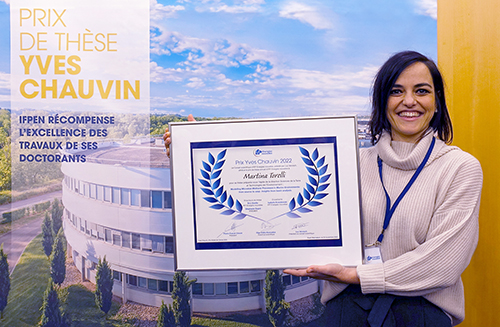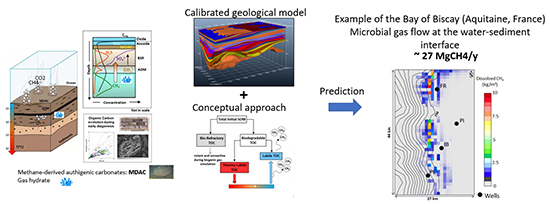 Thesis prepared by Martina Torelli, winner of the 2022 Yves Chauvin prize"Modelling Microbial Methane Processes in Marine Environments: from Source to Seep. Insights from Basin Analysis"
Thesis prepared by Martina Torelli, winner of the 2022 Yves Chauvin prize"Modelling Microbial Methane Processes in Marine Environments: from Source to Seep. Insights from Basin Analysis"
Just like carbon dioxide (CO2), but with a much higher GWPa, methane (CH4) is a gas which, according to the IEAb, is responsible for around 30% of the increase in global temperatures since the industrial revolution.
The biological and abiotic processes that govern its concentration in the atmosphere remain poorly understood. One contribution that is still much debated is that related to the degradation of organic matter contained in marine sediments, at the continental marginsc. CH4 escaping from the seabed can mix with sea water and then enter the atmosphere, and some of it can remain stored in the form of gas hydrates. However, depending on local changes in pressure and temperature conditions, these gas hydrates can release massive quantities of methane, contributing to modifications in the chemical composition of the oceans and atmosphere (if they pass through the water column). This result would be a vicious circle: a recent study relating to the southwestern Atlantic [1] has shown that current ocean warming may amplify this phenomenon by causing the long-term destabilization of these gas hydrates.
To date, the quantities of CH4 actually reaching the atmosphere from the seabed are uncertain and probably underestimated. Estimates vary between 3% and 9% of global emissions [2], based on insufficient available data obtained from petroleum exploration and scientific drilling campaigns.
Large-scale modeling is proving to be a useful additional tool for understanding and quantifying past and present flows from the seabed likely to merge with sea water and potentially enter the atmosphere, thereby gradually altering their composition.
With its expertise in the field of sedimentary basin modeling and simulation, IFPEN hosted a PhD thesis on the subject, within the framework of the PAMELA (PAssive Margins Exploration LAboratories) research program [3]d. An original approach, using the TemisFlow™ software, was used to evaluate the quantities of gas generated in the seabed, following the microbial decomposition of organic matter, as well as the quantity trapped in the form of carbonates, in order to determine the evolution in time of carbon flows (CH4 et CO2) in natural seabed conditions.
This research was an opportunity to explain the processes of alteration of sedimentary organic matter [4] and the strategy adopted then consisted in constructing a model coherent with the basin geology:
- incorporating the geological history as well as data characterizing the sedimentary organic matter (SOM);
- describing the processes involved in the formation/migration and trapping of microbial gases.
This approach has been applied to the Aquitaine basin (Bay of Biscay) [5] and is illustrated in the figure below. The modeling results show that current methane flows (27 Mg CH4/year) are similar to those estimated from in-situ flow measurements and acoustic data (35 Mg CH4/year) [6].
By demonstrating the ability of a simulation tool initially developed for petroleum exploration purposes to describe large-scale complex phenomena likely to amplify climate change, this research illustrates IFPEN’s policy of using its resources to meet new challenges.

a- global warming potential: the heat absorbed by any greenhouse gas in the atmosphere as a multiple of the heat absorbed by the same mass of carbon dioxide.
b- IEA (2022), Global Methane Tracker 2022, IEA, Paris >> https://www.iea.org/reports/global-methane-tracker-2022, License: CC BY 4.0
c- underwater zone located at the edge of continents to where the vast majority of the sediment generated by continental erosion is transported.
d- also involving TOTAL Energies, IFREMER, the CNRS and the Universities of Western Brittany (UBO), Rennes 1 and Paris VI.
Bibliographic References:
-
Ketzer, M., Praeg, D., Rodrigues, L.F. et al. "Gas hydrate dissociation linked to contemporary ocean warming in the southern hemisphere", Nature Communications 11, 3788 (2020).
>> https://doi.org/10.1038/s41467-020-17289-z
-
Judd, A.G., Hovland, M., Dimitrov, L.I., García Gil, S. and Jukes, V. (2002), "The geological methane budget at Continental Margins and its influence on climate change", Geofluids, 2: 109-126.
>> https://doi.org/10.1046/j.1468-8123.2002.00027.x
-
PAMELA : PAssive Margins Exploration LAboratories
>> https://campagnes.flotteoceanographique.fr/series/236/
-
Torelli M., Battani A., Pillot P., Kohler E., Lopes De Azevedo J., Kowalewski I., Pastor L., Brandily C., Schmidt S., Jouet G., Deville E. (2021). "Origin and Preservation Conditions of Organic Matter in the Mozambique Channel: Evidence for Widespread Oxidation Processes in the Deep-Water Domains", Marine Geology, 440, 106589 (16p.).
>> https://doi.org/10.1016/j.margeo.2021.106589
-
Torelli M., Kowalewski I., Gervais V., Wendebourg J., Dupré S., Wolf S., Gout C., Deville E. (2021). "Quantification of natural microbial methane from generation to emission in the offshore Aquitaine: A basin modelling approach", Marine and Petroleum Geology Vol. 127, pp. 1049490
>> https://doi.org/10.1016/j.marpetgeo.2021.104949
-
Dupré, S. Loubrieu, B. Pierre, C. Scalabrin, C. Guérin, C. Ehrhold, A. Ogor, A. Gautier, E. Ruffine, L. Biville, R. Saout, J. Breton, C. Floodpage, J. Lescanne, M. (2020) "The Aquitaine Shelf Edge (Bay of Biscay): A Primary Outlet for Microbial Methane Release", Geophysical Research Letters 47.
>> https://doi.org/10.1029/2019GL084561
Scientific contacts: Isabelle Kowalewski ; eric.deville@ifpen.fr






